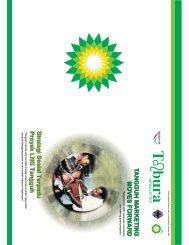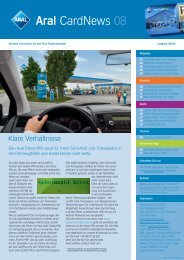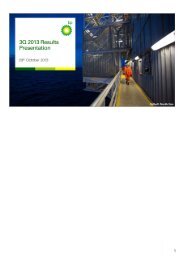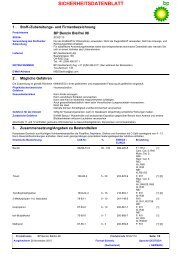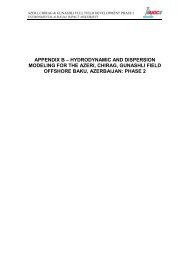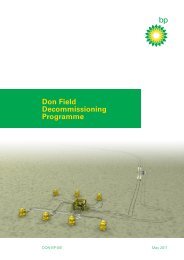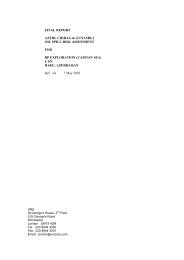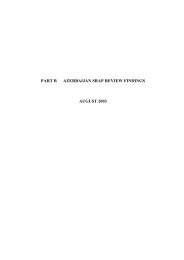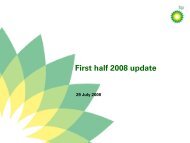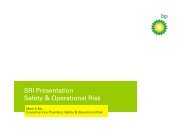BP in Angola Sustainability Report 2010 (pdf, 3860KB)
BP in Angola Sustainability Report 2010 (pdf, 3860KB)
BP in Angola Sustainability Report 2010 (pdf, 3860KB)
You also want an ePaper? Increase the reach of your titles
YUMPU automatically turns print PDFs into web optimized ePapers that Google loves.
<strong>BP</strong> <strong>Angola</strong> <strong>in</strong> Figures<br />
<strong>BP</strong> <strong>Angola</strong> <strong>in</strong> figures<br />
Performance data<br />
For the year ended 31 December 2006 2007 2008 2009 <strong>2010</strong><br />
Total hydrocarbons produced (mboed) (Op and non–op) 133 140 202 211 170<br />
Safety<br />
For the year ended 31 December 2006 2007 2008 2009 <strong>2010</strong><br />
<strong>BP</strong> employee fatalities 0 0 0 0 0<br />
<strong>BP</strong> contractor fatalities 0 0 0 0 0<br />
Day away from work cases (DAFWC) a – workforce b 2 4 4 5 0<br />
Day away from work cases frequency (DAFWCf) c – workforce 0.062 0.094 0.095 0 0<br />
Recordable <strong>in</strong>juries d – workforce 8 18 15 9 3<br />
Recordable <strong>in</strong>jury frequency (RIF) e – workforce 0.25 0.42 0.35 0.2 0.07<br />
Total vehicle accidents 78 31 30 39 23<br />
Total vehicle accident rate (TVAR) f 23.3 9.3 14.3 14.8 7.9<br />
Hours worked – workforce 6,433,581 8,545,184 8,549,274 8,986,787 8,344,661<br />
Kilometres driven 3,340,962 3,346,010 2,102,528 2,639,650 2,917,951<br />
Environment<br />
For the year ended 31 December 2006 2007 2008 2009 <strong>2010</strong><br />
Equity share direct carbon dioxide (CO ² ) g – (tonnes) 484,666 940,541 1,208,764 1,162,490 1,055,204<br />
Equity share <strong>in</strong>direct carbon dioxide (CO ² ) h (tonnes) 0 0 0 0 0<br />
Equity share direct methane (CH 4 ) (tonnes) 1,643 4,160 2,644 2,502 2,444<br />
Equity share direct greenhouse gas (GHG) (tonnes CO ² equivalent) i 519,169 1,027,811 1,264,288 1,215,032 1,106,528<br />
Total gas flared (tonnes) 1,987 148,882 200,221 138,093 227,851<br />
Sulphur dioxide (Sox) (tonnes) 108 232 206 259 98<br />
Nitrogen oxides (NOx) (tonnes) 1,587 5,800 2,923 1,849 928.4<br />
Non–methane hydrocarbons (NMHC) (tonnes) 260 825 6,210 4,789 6,766<br />
Losses of primary conta<strong>in</strong>ment j – – 33 15 0<br />
Number of hydrocarbon spills k 0 0 2 1 0<br />
Volume of product spilled (litres) 0 0 835.95 208 0<br />
Volume of product unrecovered (litres) 0 0 635.95 208 0<br />
Total hydrocarbon discharges to water (tonnes) 0 0 3.18 14.11 45.58<br />
Hazardous waste disposed (tonnes) 673 1,054 768 1,070 1,035<br />
Non-hazardous waste disposed (tonnes) – 749 870 1,147 426<br />
Employees<br />
For the year ended 31 December 2006 2007 2008 2009 <strong>2010</strong><br />
<strong>Angola</strong>n nationals <strong>in</strong> <strong>BP</strong> 337 367 473 461 507<br />
Non-<strong>Angola</strong>n nationals based <strong>in</strong> <strong>Angola</strong> 80 172 168 142 113<br />
Total 417 539 641 603 620<br />
a DAFWC: An <strong>in</strong>jury or illness is classified as a Day Away From Work Case (DAFWC) if as a<br />
consequence of it the member of the <strong>BP</strong> workforce could not have worked on any day after the<br />
<strong>in</strong>jury or illness, irrespective of whether there was scheduled work, or when a physician or other<br />
licensed health care professional recommends that the member of the <strong>BP</strong> workforce stay at<br />
home but the <strong>in</strong>dividual comes to work anyway.<br />
b The <strong>BP</strong> workforce comprises all <strong>BP</strong> employees, all <strong>BP</strong> contractors and all <strong>BP</strong> Directors.<br />
c DAFWCf workforce: The number of <strong>in</strong>jury DAFWCs to the <strong>BP</strong> workforce for every 200,000<br />
hours worked <strong>in</strong> the same period.<br />
d A recordable <strong>in</strong>jury is an <strong>in</strong>jury and illness <strong>in</strong>cident that results <strong>in</strong> a fatality, a day away from work<br />
case, restricted work or job transfer, or medical treatment beyond first aid.<br />
e RIF: The total number of Recordable Injuries to the <strong>BP</strong> workforce for every 200,000 hours<br />
worked <strong>in</strong> the same period.<br />
f TVAR: Total Vehicle Accident Rate: the sum of all light vehicle and all mobile plant accidents per<br />
one million kilometres driven.<br />
30 <strong>BP</strong> <strong>in</strong> <strong>Angola</strong> Susta<strong>in</strong>ability <strong>Report</strong> <strong>2010</strong><br />
g Direct GHG emissions are the physical emissions from operations on an equity share basis.<br />
h Indirect GHG emissions are a consequence of the import by operations of steam, electricity and<br />
heat on an equity basis from third–party sources.<br />
i Greenhouse gas emissions <strong>in</strong>clude carbon dioxide and methane (converted to the quantity of<br />
CO2 that would create an equivalent warm<strong>in</strong>g effect).<br />
j Loss of primary conta<strong>in</strong>ment: An unplanned or uncontrolled release of material from primary<br />
conta<strong>in</strong>ment.<br />
k Hydrocarbon spill: An accidental or unplanned loss of hydrocarbon greater than or equal to one<br />
barrel from primary conta<strong>in</strong>ment from a <strong>BP</strong> or contractor operation, irrespective of any secondary<br />
conta<strong>in</strong>ment or recovery. (One barrel is equal to 159 litres, equivalent to 42 US gallons). Historic<br />
data has been revised to meet latest <strong>BP</strong> report<strong>in</strong>g def<strong>in</strong>itions.




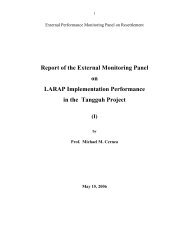
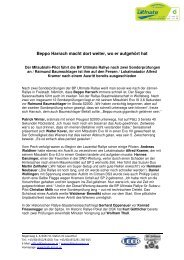
![[PDF] Deepwater Horizon: Accident Investigation Report - BP](https://img.yumpu.com/51697031/1/190x245/pdf-deepwater-horizon-accident-investigation-report-bp.jpg?quality=85)
